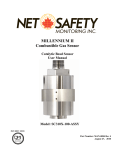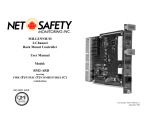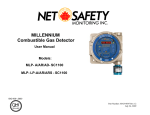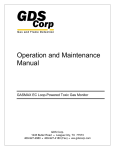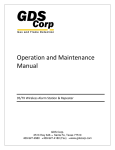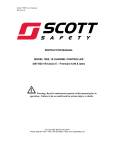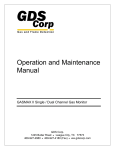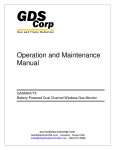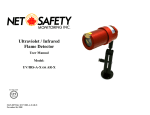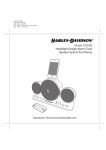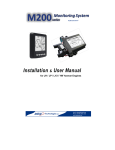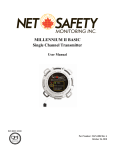Download ECO-SENSE SINGLE CHANNEL TRANSMITTER User Manual
Transcript
ECO-SENSE SINGLE CHANNEL TRANSMITTER User Manual MODEL: ECO-A-X MAN-0114 Rev 0 February 11, 2010 Table of Contents SECTION 1 – SAFETY INFORMATION ............................................................... 1 1.1 1.2 Safety Information – Read Before Installation & Applying Power ......................... 1 Contacting Net Safety Monitoring Inc. ...................................................................... 1 SECTION 2 – INSTALLATION INSTRUCTIONS ................................................. 2 2.1 2.2 2.3 2.4 2.5 2.6 2.7 Introduction .................................................................................................................. 2 Ratings and Certifications .......................................................................................... 2 Transmitter / Sensor Location ................................................................................... 3 The ECO-A-X Enclosure.............................................................................................. 4 System Design Specifications ................................................................................... 5 Field Wiring Installation .............................................................................................. 5 2-Wire 4-20mA Explosion Proof Installations ........................................................... 5 ECO-A-X Transmitter Board Terminals .......................................................................... 6 SECTION 3 – INITIAL START-UP ....................................................................... 7 3.1 “Transmitter Configuration” Menu ............................................................................ 7 3.1.1 Single Gas Monitor Configuration ...................................................................... 7 3.1.2 Output Zero / Output Span Trims (Factory Preset, Technicians only!): ......... 7 3.1.3 Model Name .............................................................................................................. 7 3.2 Initial Toxic Monitor Start-Up ..................................................................................... 7 3.2.1 Initial Toxic Monitor “Span” Check ................................................................... 7 SECTION 4 – OPERATING INSTRUCTIONS ...................................................... 8 4.1 4.2 Routine Sensor Calibrations ...................................................................................... 8 ALARM OPERATION ................................................................................................. 10 4.2.1 ALARM 3 – UNDERSTANDING FAULT / LEVEL OPERATION ....................... 10 SECTION 5 – SETUP MENU CONFIGURATION .............................................. 11 5.1 5.2 5.3 Menus Database Configuration ............................................................................... 11 Configuration Using the Magnet:............................................................................. 11 System Configuration Menus: ................................................................................. 12 Measurement Name........................................................................................................ 12 Eunits ............................................................................................................................... 12 Zero .................................................................................................................................. 12 Span ................................................................................................................................. 12 Decimal Points ................................................................................................................ 12 Cal Span Value ................................................................................................................ 12 Readout Deadband ......................................................................................................... 12 Track Negative ................................................................................................................ 12 Linearization Data ........................................................................................................... 13 Backup Config. ............................................................................................................... 13 Restore Config. ............................................................................................................... 13 5.4 Alarm Settings: .......................................................................................................... 14 5.5 Sensor Information: .................................................................................................. 15 5.6 CLOCK/DELAY SETUP: ............................................................................................ 15 5.7 LCD Contrast Adj: ..................................................................................................... 16 5.8 HELP Screen: ............................................................................................................. 16 5.9 Diagnostics: ............................................................................................................... 16 5.10 SYSTEM SECURITY: ................................................................................................. 17 5.11 TECHNICIANS ONLY MENUS: .................................................................................. 17 Troubleshoot ................................................................................................................... 17 SECTION 6 – HOW TO RETURN EQUIPMENT ................................................ 18 Appendix ........................................................................................................... 19 Appendix A: Electrostatic Sensitive Device (ESD) ............................................................ 19 Appendix B: Resistance Table ............................................................................................ 20 Appendix C: ECO Sense Specifications ............................................................................. 21 1 SECTION 1 – SAFETY INFORMATION WARNING: Read and understand the contents of this manual prior to operation. Failure to do so could result in injury or death. Note: Users are responsible for correct translations of this manual into their native language. 1.1 Safety Information – Read Before Installation & Applying Power IMPORTANT Users should have a detailed understanding of ECO-SENSE (ECO-A-X) Transmitter operating and maintenance instructions. Use the transmitter only as specified in this manual or detection of gases and the resulting protection provided may be impaired. Read the following WARNINGS prior to use. WARNINGS: • • • • • • • • • Calibrate with known target gas at start-up and check on a regular schedule, at least every 90 days. More frequent inspections are encouraged to spot problems such as dirt, oil, paint, grease or other foreign materials on the sensor head. Do not paint the sensor assembly or the Transmitter. Do not use the ECO-A-X if its enclosure is damaged or cracked or has missing components. Make sure the cover, internal PCB’s and field wiring are securely in place before operation. Use only a sensor assembly compatible with the unit and approved by Net Safety. Periodically test for correct operation of the system’s alarm events by exposing the monitor to a targeted gas concentration above the High Alarm setpoint. Do not expose the unit to electrical shock or continuous severe mechanical shock. Protect the unit from dripping liquids and high power sprays. Use only for applications described within this manual. CAUTION: FOR SAFETY REASONS THIS EQUIPMENT MUST BE OPERATED AND SERVICED BY QUALIFIED PERSONNEL ONLY. READ AND UNDERSTAND INSTRUCTION MANUAL COMPLETELY BEFORE OPERATING OR SERVICING. ATTENTION: POUR DES RAISONS DE SÉCURITÉ, CET ÉQUIPEMENT DOIT ÊTRE UTILISÉ, ENTRETENU ET RÉPARÉ UNIQUEMENT PAR UN PERSONNEL QUALIFIÉ. ÉTUDIER LE MANUE D’INSTRUCTIONS EN ENTIER AVANT D’UTILISER, D’ENTRETENIR OU DE RÉPARER L’ÉQUIPEMENT. WARRANTY – Net Safety Monitoring Inc., warrants this product against defective parts and workmanship for a period of 24 months from date of purchase. No other warranties or liabilities expressed or implied, will be honoured by Net Safety Monitoring Inc. Contact Net Safety Monitoring Inc., or authorized distributor for details. 1.2 Contacting Net Safety Monitoring Inc. To contact Net Safety Monitoring. Inc., call, fax, email or write: 403–219-0688 FAX 403-219-0694 Email: [email protected] 2721 Hopewell Place NE Calgary AB. Canada T1Y 7J7 Or visit us on the World Wide Web: www.net-safety.com 1 SECTION 2 – INSTALLATION INSTRUCTIONS 2.1 Introduction Important: This manual describes the 2-Wire 4-20mA versions of the ECO-A-X. The unit is a fixed-point monitor designed to provide continuous monitoring of hazardous gases in the workplace. Monitored values are displayed in their engineering units as well as graphically as a bar graphs or 30-minute trends (Figure 2.1). Input is for the electrochemical toxic sensor which is supplied by the factory. The ECO-A-X advanced microcontroller electronics and superior graphic LCD operator interface offers enhanced diagnostics and fault analysis not possible in competing products. The unit provides a standard 4-20 mA output signal for connection to control systems or other alarm instrumentation. Non-volatile memory retains all configuration data during power interruptions. Magnetic, non-intrusive calibration can be easily performed by one person without opening the enclosure. A standard “real time clock & calendar” feature allows data logging of calibrations and alarm events for recall to the LCD readout. Only periodic calibration checks are needed to assure dependable performance. Operator interface is very intuitive with the LCD displaying data both graphically as bar-graphs / trends and in engineering units (Figure 2-1). Additional features include: • • • • • • • • • No potentiometer or jumper settings required. All setup is with menus accessed via the LCD / magnetic keypad operator interface without opening the enclosure. Field adjustable alarm levels may be high, low, fault, fail-safe, latching and acknowledgeable. New alarms cause front LED’s to flash and become steady after acknowledge. CAL MODE advises when to apply gas during calibrations One half hour trend screen shows rate of change of gas exposures Sensor life bar-graph updates after each SPAN calibration. Modular design affords efficient installation and plug in sensors allow changing target gases after installation New smart sensors are recognized by the ECO-A-X and prompts users to either upload new configuration data or continue with data from the previous smart sensor. Sensors are industry proven for fast response and long life. Engrg. Units / Bar Graph ALM RST UP/ ALM1 ALM2 Engrg. Units / 30-Minute Trend ALM RST UP/ ALM1 ALM2 NEXT FAIL FAIL NEXT 10 PPM H2S 10 PPM H2S Me a s u r e me n t DOWN/CAL N a me RXD NEXT key toggles readout RXD RS485 RS485 TXD EDIT TXD DOWN/CAL EDIT Figure 2-1: Data Displays 2.2 Ratings and Certifications ATEX certified for hazardous locations. ATEX certificate # DNV 09 ATEX 60195X. Refer to Appendix C for information on specification and certification. Special Conditions of Safe Use (X): Enclosure volume shall not be increased by the addition of the Ex d sensor. 2 2.3 Transmitter / Sensor Location Prior to the installation process, a location plan for placing the transmitter and sensor should be developed. Factors such as accessibility, air movement, gas density in relation to air, emission sources and environmental variables affect correct sensor and transmitter location. Air movement by fans, prevailing winds and convection should be carefully evaluated to determine if a leak is more likely to raise gas levels in certain areas within the facility. Vapor density of a gas determines if it will rise or fall in air when there are no significant currents. Lighter than air gases should have the monitors mounted 12 – 18 inches (30 – 45 centimeters) above the potential gas leak and heavier than air gases should be this distance below. Even though the ECO-A-X is designed for rugged service, sensors should be protected from environmental damage from water, snow, shock, vibration and dirt. Consider the following points when planning installation: • • • • • • • • Locate the controller where it will be accessible and visible. Carefully locate sensor in an area where gases may potentially accumulate. Use redundant systems to enhance protection and reliability. Light gases tend to rise; heavy gases tend to accumulate in low areas. Consider the air movement patterns within the facility. Consider the construction of the facility (such as trenches where heavy gases may accumulate or peaks where light gases may accumulate) Seek advice from experts knowledgeable about the primary gas to be detected. Use common sense and refer to the regulatory publications that discuss guidelines for your industry. The two most common installations options are as follows. Option 1 The sensor may be installed separated from the transmitter using a Certified Junction Box. If the Net Safety Junction Box is being used, refer to JB-MPG-A/S in the Net Safety Multipurpose Junction Box (MAN-0081) for terminal designations. The transmitter is located near eye- level. Conduit is run from the controller to the sensor. A Calibration Cup (CCS-1) can be attached to the sensor. Tubing can be run from the CCS-1 to a convenient location accessible for calibration gas to be injected. Option 2 The sensor is wired directly to the controller. CCS-1 and tubing is used to facilitate calibration. Controller (Transmitter) and sensor wired- separated drawing CCS-1 3 2.4 The ECO-A-X Enclosure The ECO-A-X enclosure is an Aluminum or Stainless Steel explosion-proof (NEMA 4X) enclosure as shown in Figure 2-2. Table 1: ECO Sense (ECO-A-X) housing and sensor dimensions (A through J) in Inches and mm ECO-A-X Transmitter & sensor Transmitter & sensor(AL) Transmitter & sensor(SS) A in 4.8 4.7 B mm 122 119 in 3.6 3.6 C mm 91 91 in 3.6 3.6 D mm 91 91 in 4.8 4.7 E mm 122 119 in 5.1 5.1 F mm 130 130 in 0.3 0.3 G mm 7.6 7.6 in 2.6 2.6 H mm 66 66 Table 1: (cont’d) ECO-A-X Transmitter & sensor Transmitter & sensor(AL) Transmitter & sensor(SS) I in 3.0 2.8 J mm 76 71 in 9.0 8.9 mm 229 226 A I B D C E J F G H Figure 2-2 ECO-A-X Explosion-Proof Housing 4 in 2.9 2.9 mm 74 74 WARNING: Qualified personnel should perform the installation according to applicable electrical codes, regulations and safety standards. Insure correct cabling and sealing fitting practices are implemented. Also, never install the sensor pointing upwards. 2.5 System Design Specifications Supply Voltage: 10 to 30 VDC Power Consumption: • Toxic Sensors (2-wire 4-20mA operation): 25 mA @ nominal 24 VDC. Memory: Non-volatile E2 memory retains configuration values in the event of power outages. Loop Resistance at nominal 24 VDC power: 650 ohms maximum in 2-wire mode. 2.6 Field Wiring Installation 4-20mA Transmission Range Info: The distance 4-20 mA signals can travel is dependent upon several factors including the cable gauge, DC power supply voltage level and impedance of the input of the receiving device. Assuming a nominal 24 VDC power supply, the maximum total loop resistance should be 650 ohms. See Appendix B for resistance table. 2.7 2-Wire 4-20mA Explosion Proof Installations ECO-A-X equipped with smart sensor heads are NRTL (Nationally Recognized Testing Lab) certified as suitable for explosion proof installations. All ECO-A-X’s are NRTL certified for explosion proof installations as long as the sensor head is certified as explosion proof. Description: The 2-wire current sinking transmitter is the easiest and most economical to install since there are only two wires. All of the power needed comes from the current loop and wire sizes may be smaller. However, only very low power applications are eligible for such transmitters. The ECOA-X Display assembly shown in Figure 2-3 consumes <2.5 mA of quiescent current. Toxic electrochemical sensors generate their own signals and therefore require no additional current. CAUTION: It is important to understand the receiver, or controller device must supply the loop power in 2-wire 4-20mA modes. Be sure the receiver to be used supports this type of operation. Instructions: Unscrew the cover on the ECO-A-X explosion-proof enclosure. Loosen the 2 thumbscrews holding the display assembly in place and remove it. A small sensor cable is attached with sufficient length to allow access to the back of the display assembly where 2 position TB1 is located. Route the receiver wires through the conduit entry and connect to TB1. Steering diodes in the ECO-A-X 2-wire 4-20mA output automatically correct for polarity so positive and negative are interchangeable. Reassemble the ECO-A-X. Follow the procedures and recommendations in the receiver manual to complete the installation. Be sure the ECO-A-X enclosure and conduit are properly grounded. Apply loop power by appropriately powering the receiver device (DCS, PLC, Controller, etc) and the ECO-A-X should function. 5 ECO-A-X Transmitter Board Terminals Backside of 10-0232 Display Assembly TB1 Top terminal Display Assy 10-0232 S4 Not used 2-WIRE 4-20mA Output (Non-Polar) (EC Only) S3 Not used Not used Wires for power and 4-20 mA output TB1 bottom terminal TB2 “Simple” electrochemical sensor input Figure 2-3: 10-0232 Display / 2-Wire 4-20mA Assembly Table 2: Sensor Terminal connection TB2 Sensor Terminals Terminal Sensor Wire designation White CTR Red REF Black SEN Table 3: Power Terminal connection TB1 Power Terminals - non polar Power TB1 Connections TB1 top (+) 24VDC terminal TB1 bottom (-) 24VDC terminal Note: In Table 3, TB1 Terminals (Power Terminals) are non-polarized; if (+) 24VDC is connected to TB1 bottom terminal, and (-) 24VDC connected to TB1 top terminal a loop current of 4-20mA would still be obtained. Sensor separation Since the sensor must be located where gas is likely to accumulate and the controller where it can be easily reached, it is often necessary to “separate” the controller and sensor. This is done with the aid of the Sensor Separation kit. The Sensor Separation kit is composed of a Net Safety Multi-purpose Junction Box and terminal strip. Refer JB-MPG-A/S in the Multi-purpose Junction Box manual (MAN-0081) for terminal designations. 6 SECTION 3 – INITIAL START-UP 3.1 “Transmitter Configuration” Menu Figure 3-1shows the ECO-A-X XMITTER CONFIG menu used to activate channels, precisely calibrate 4-20mA outputs and set time / date. Its menus are set at the factory and typically not needed by the user. To access from any data display, place and hold the magnet over the NEXT key for 5-seconds until the screen appears requesting a special key sequence (4-UP keystrokes). XX XXX Figure 3-1: Transmitter Configuration Menu 3.1.1 Single Gas Monitor Configuration ECO-A-X’s are 2-wire 4-20mA devices and supports only one electrochemical sensor at this time. 3.1.2 Output Zero / Output Span Trims (Factory Preset, Technicians only!): The Output Zero Trim / Output Span Trim entries are digital to analog (D2A) values that determine the ECO-A-X’s final 4-20mA output. Their purpose is to provide precise 4mA and 20mA outputs. 3.1.3 Model Name When power is applied to the ECO-A-X it will briefly show a 10 digit ASCII model name or company name as it starts up. The name can be edited in the Transmitter Configuration menu by editing the Model field. 3.2 Initial Toxic Monitor Start-Up ECO-A-X Toxic Monitors are factory equipped with an electrochemical sensor which rarely requires adjustments (other than routine calibrations) to provide accurate readings. After installation checks should however be performed to ensure proper operation. In addition, alarm levels, Measurement Name, ASCII fields and other variables may require attention by users in order to best serve their application. 3.2.1 Initial Toxic Monitor “Span” Check Prior to the initial Routine Sensor Calibration described below, a coarse SPAN gas reading verification should be performed after installation. Apply an upscale gas value of at least 25% of full scale to the sensor. For example, if 0-100ppm H2S is the measurement range, apply at least 25ppm but not more than 100ppm. The indicated value should read within 15% of full scale. Remember that this is only a coarse check and precision calibrations are performed in Routine Sensor Calibrations described in the following section 4.1. 7 SECTION 4 – OPERATING INSTRUCTIONS 4.1 Routine Sensor Calibrations Calibration is the most important function for ensuring correct operation of the ECO-A-X. The CAL MODE (flow chart shown in Figure 4-2) is designed to make calibration quick, easy and error free. A successful ZERO and SPAN calibration requires only four keystrokes. The 4-20mA output indicates CAL MODE by transmitting 3mA. It then transmits 4mA during the subsequent CAL PURGE delay to prevent external alarms during calibration. CAL MODE automatically exits if no keystrokes are detected after 5 minutes. Follow these calibration guidelines below and also see calibration steps on next page. • • • • • Calibration accuracy is only as good as the calibration gas accuracy. Do not use a gas cylinder beyond its expiration date. Calibrate a new sensor before use. Allow the sensor to stabilize before starting calibration (approximately 5 minutes). Calibrate on a regular schedule. (Net Safety Monitoring recommends once every 3 months, depending on use and sensor exposure to poisons and contaminants.) Calibrate only in a clean atmosphere, which is free of background gas (contaminants). ECO-A-X ST-48 Sensor Transmitter Sensor assembly with Calibration Cup Calibration Tubing Calibration Gas Figure 4-1: Calibration Gas Input 8 Calibration Steps Use the following step-by-step procedure to perform ZERO and SPAN calibrations. 1. To enter the CAL MODE activate the DOWN / CAL key with the magnet and within 5 seconds activate the EDIT key. 2. Using the Cal-Cup, apply clean ZERO gas (air) from canister or be sure there is no background target gas in the monitored area if ambient air is used. After the reading is stable, (approximately 1 minute) activate the EDIT key to perform a ZERO calibration. 3. If the ZERO calibration is successful, activate the NEXT key to proceed to the SPAN check. 4. Apply the correct SPAN gas at 0.5 liters/min. After the reading is stable, (approximately 1 minute) activate the EDIT key to perform a SPAN calibration. WARNING: The SPAN gas used must match the value specified since this is what the ECO-A-X will indicate after a successful SPAN calibration. The Cal Span Value may be edited if it becomes necessary to apply a different gas concentration (see Set Span Value at top of flow chart below). 5. If the SPAN calibration is successful, the display flashes “REMOVE CAL GAS” and starts the CAL PURGE delay. 6. CAL MODE will be complete after the end of the CAL PURGE delay. The flow chart in Figure 4-2 illustrates the above procedure. UP, CAL, NEXT & EDIT labels indicate keystrokes using the magnet. The CAL MODE information screen (top of the chart) is available for advanced users to see Offset / Gain calibration constants and live analog to digital converter (A/D) counts. Span Gas calibration values may also be edited from this screen. Holding the UP key, for 5 seconds during CAL MODE, displays this screen. Calibration history records are logged and may be viewed in the Sensor Information menu (see section 5-5). PPM H2S PPM H2S Figure 4-2: Cal-Mode Flow Chart and Menus 9 4.2 ALARM OPERATION The ECO-A-X has front panel LED indicators for Alarm 1(ALM1), Alarm 2(ALM2) and Alarm 3(FAIL). With 2-Wire 4-20mA operation, to conserve power, alarm LED’s only flash during alarm events. 4.2.1 ALARM 3 – UNDERSTANDING FAULT / LEVEL OPERATION The “A3”(FAIL) alarm is typically dedicated to FAULT conditions indicating sensor failures or “out of measurement range” conditions. However, some applications require a third level alarm. The A3 menu is identical to A1 & A2 and may be set to trip at an upscale level value. A3 WILL ALSO TRIP WITH MISSING OR FAILED SENSORS REGARDLESS OF THE LEVEL VALUE! CAUTION: Missing or failed sensors always trip Alarm 3. This is true even with A3 configured as a level alarm and it must be accepted that A3 level alarm events might be caused by the monitored level, or, by a missing or failed sensor. 10 SECTION 5 – SETUP MENU CONFIGURATION 5.1 Menus Database Configuration All ECO-A-X configuration variables are stored in its menu database. Many menu items will contain default values from the factory and require changes to better match a user’s particular application. ECO-A-X menus may be configured from the magnetic keypad in 5-10 minutes per transmitter. The ECO-A-X configuration menus are shown in Figure 5-1. Pressing EDIT from either data display enters the EC SETUP PAGE 1 menu. E C I NP UT S y s t e m Co n f i Al a r m Se t t i n Se n s o r Inf or Cl o c k / De l a y s Di a g n o s t i c s HE L P 1 g. gs ma t i o n > > > > > (Instructions) > S Y S T E M C ON F I G. P G 1 Me a s u r e me n t N a me - 16 E u n i t s X X X X X X X X X X - 10 Z e r o ( 0 %) (Eunits) S p a n ( 10 0 % ) (Eunits) D e c i ma l Po i n t s 0 Ca l Sp a n Va l 50 S Y S T E M C ON F I G. P G 2 Re a d o u t De a d b a n d 0 % T r a c k Ne g a t i v e NO L i n e a r i z a t i o n Da t a > B a c k u p Co n f i g . > > *R e s t o r e C o n f i g . Da t a > **U p l o a d S e n s o r TX Se n s o r Li f e NO UP/ DOWN CURV E PRESS EDIT En t e r Ke y Se q u e n c e t o a c c e s s me n u . * * * * NE X T k e y t o E x i t . Se e Ma n u a l / PRESS UP KEY 4-TIMES P OI N T S Li near i ze ? NO Da t a P o i n t 1 % Input 10 . 0 0 % Ou t p u t 10 . 0 0 HE L P *Simple Sensor Installed **Smart Sensor Installed > > > A L A RM Al a r m Al a r m Al a r m Re l a y Ev e n t A L A RM S E T T I N GS x S E T UP Se t Po i n t De a d B a n d ON D e l a y OF F D e l a y Low Tr i p Lat c hi ng > 1 > 2 > 3/ Fai l C o n f i g .(Not used) > Log > 20 1% 0s 0m NO NO Alarm 1, 2, 3 menus are identical E V ENT L OG Di s p l a y E v e n t Log Cl e a r Ev e n t Log RE L A Y C ON F I G (Not used) K1 Fa i l s a f e NO K2 Fa i l s a f e NO K 2 A c k n o wl e d g e NO K 2 Re f r e s h Of f * K 3 a l wa y s F a i l s a f e * S E T UP / I NF O 0 0 0 0 0 0 0 0 8 8 8 8 8 8 8 8 / / / / / / / / 12 12 12 12 12 12 12 13 / / / / / / / / 0 0 0 0 0 0 0 0 4 4 4 4 4 4 4 4 0 3 : 17 03:51 03:55 0 4 : 16 04:23 15 : 0 0 16 : 4 3 02:08 A1 I N A2 I N A CK A 2 OU T A 1O U T A1 I N A 1O U T A3 I N Down Not used S E N S OR Edit 0 8 / 13 / 0 4 - - - E ND 0 2 : 18 A 3 O U T OF L OG- - - EDIT Re c a l l Ca l Hi s t o r y > Input Ty pe H 2 S E C > Ne w S e n s o r 0 1/ 2 8 / 0 4 Re c e n t Ca l 04/ 05/ 04 Se n s o r Li f e CL OC K / D E L A Y C A L I B R A T I ON S E T UP T i me 12 : 3 5 : 4 2 Da t e 04/ 22/ 04 Wa r m U p S e c 10 0 Ca l Pu r g e Se c 10 0 Re c o r d 2 2 CA L Da t e : U P / D O WN NE X T t o DA T E S of 22 04/ 05/ 04 t o scr ol l EXI T. C ON T R A S T U P / D O WN NE XT t o change t o EXIT * * * En t e r Ke y Se q u e n c e t o a c c e s s me n u . * * * * NE X T k e y t o E x i t . Se e Technicians Only Ma n u a l SYSTEM / PRESS UP KEY 4-TIMES HE L P WA R N I N G * * * A l a r m p r o c e s s i n g wi l l be hal t ed dur i ng d i a g n o s t i c mo d e ! EDI T t o c o n t i n u e . An y o t h e r t o exi t . D I A GN O S T I C S EDIT Ou t p u t S i mu l a t i o n Re l a y T e s t E DI T Ne x t S T I MU L A T O R 4.0 t o t o mA change. exi t . Not used S E CURI T Y Co n t a c t N a me Se c u r e L e v e l P a s s Co d e OU T P U T Ou t p u t L OW Un l o c k e d ACT UAT E Re l a y Re l a y Re l a y RE L A Y S 1 2 3 OF F OF F OF F Not used WARNING! Variables in the “Technicians Only” menu are critical for correct operation. A thorough understanding of each variable is required. Figure 5-1: Configuration Menu Tree 5.2 Configuration Using the Magnet: Passing the magnet over the EDIT key, from either data display, displays SETUP PAGE 1 as shown in Figure 5-2. The UP / DOWN keys maneuver the pointer while EDIT enters sub levels of menu items. All SETUP menu items have at least one page of sub-menus. Items with submenus are indicated by the > symbol (right hand pointing arrow) at the end of each line. To edit menu items use UP / DOWN keys to point to them, then activate the EDIT key to enter these 11 items/sub menus. Use EDIT key to display the cursor, then activate UP / DOWN key to change that character, activate NEXT to move the cursor, then activate EDIT key again to load the new item and remove the cursor. Activate NEXT to back out of the sub-menu. To view SETUP PAGE 2, activate the DOWN key with the pointer aimed at the bottom item on PAGE 1. E C I NP UT 1 S y s t e m Co n f i g . Al a r m Se t t i n g s Se n s o r I n f o r ma t i o n Cl o c k / De l a y s Di a g n o s t i c s HE L P (Instructions) > > > > > > Figure 5-2: Setup Menu Entry 5.3 System Configuration Menus: The System Config. group consists of two pages of menus as shown in Figure 5-3. Each item’s description follows in this section. S Y S T E M C ON F I G. P G 1 Me a s u r e me n t N a me - 16 E u n i t s X X X X X X X X X X - 10 Z e r o ( 0 %) (Eunits) S p a n ( 10 0 % ) (Eunits) D e c i ma l P o i n t s 0 Ca l S p a n Va l 50 UP/ DOWN S Y S T E M C ON F I G. P G 2 Re a d o u t De a d b a n d 0 % T r a c k Ne g a t i v e NO L i n e a r i z a t i o n Da t a > Ba c k u p Co n f i g . > > Restore Config. TX Se n s o r L i f e NO > Figure 5-3: System Config. Menus Measurement Name may be edited to contain virtually any 16-character ASCII field. It is typically used to describe the monitored point by user tag # or other familiar terminology. Eunits (engineering units) may have up to a 10 character ASCII field. Many common gases have pre-configured Eunits based upon the sensor type and each may be edited in this menu as described in Configuration Using the Magnet section 5-2. Zero (0%) defines the reading to be displayed when 4mA (0%) is the ECO-A-X’s output. Span (100%) defines the reading to be displayed when 20mA (100%) is the ECO-A-X’s output. The highest reading allowed is 9999 includes negative polarity sign and one decimal point. Polarity is only indicated for negative readings. Decimal Points sets the resolution of the LCD readings and may be for 0, 1 or 2. Example: ZERO readings for 0, 1 & 2 DP’s respectively are 0, 0.0 & 0.00. Cal Span Value sets what upscale value must be applied when performing Span calibrations. Readout Deadband allows forcing low values to continue to read zero. This is useful when there are small amounts of background gases that cause fluctuating readouts above zero. The highest amount of deadband allowed is 5%. The 4-20mA output is not affected by this menu item. Track Negative, set to NO, causes negative values to read the Zero (0%) value in data displays. The CAL MODE readout displays negative values regardless of this setting and negative values below the Fault set point will still cause the Fault alarm to trip. The 4-20mA output always locks at 4mA when the reading is negative. 12 Linearization Data allows nonlinear signals to be linearized by entering the correct curve into the ECO-A-X (Figure 5-4). If Linearize is set for NO, the CURVE POINTS menu data is not used and no linearization is applied. When YES, the CURVE POINT entries are used and a straightline approximation is calculated between each of the 9 entries. 0% input always provides 0% output and 100% input always provides 100% output. To prevent accidental data entry a special keystroke sequence, of 4 consecutive UP keys, is required to enter this menu. CURV E En t e r Ke y Se q u e n c e t o a c c e s s me n u . * * * * NE X T k e y t o E x i t . Se e PRESS UP KEY 4-TIMES P OI N T S Li near i ze ? NO Da t a P o i n t 1 % Input 10 . 0 0 % Ou t p u t 10 . 0 0 Ma n u a l Figure 5-4: Linearization Menu Backup Config. allows users to store the entire current ECO-A-X’s menu database into nonvolatile memory for restoration later if incorrect values are accidentally entered or uploaded. Restore Config. restores the ECO-A-X’s menu database to the values from the most recent Backup Config. The special keystroke sequence of 4 consecutive UP keys is also required to perform backup and restore operations. TX Sensor Life set for YES, causes the unit’s 4-20mA output to transmit a sensor life value after successful calibrations during the CAL PURGE delay (see section 4.1). For normal operation the ECO-A-X transmits 4mA during the CAL PURGE delay. But with the TX Sensor Life = YES the unit transmits 4mA for the first 10-seconds, then for 5-seconds transmits a value between 4mA and 5mA, with 4mA equal to 0% sensor life and 5mA equal to 100% sensor life (see Figure 5-5). The output then returns to 4mA for the remainder of the CAL PURGE delay. For example, if after a calibration sensor life is 75%, the ECO-A-X transmits 4.75mA during the 5second interval. Note: TX Sensor Life should always be set for NO unless the 4-20mA receiver is capable of interpreting the sensor life signal. 4mA for 10 seconds after Cal Exit Then, 4 - 5mA for 5 seconds Sensor Life Value 4mA=0% life 5mA=100% life 4mA Monitoring Monitoring Cal level = 1.5mA if 3-wire transmitter Cal level = 3.0mA if 2-wire transmitter Calibrating Cal Delay Figure 5-5: Transmit Sensor Life Timing Diagram 13 5.4 Alarm Settings: The Alarm Settings page has the Alarm 1, 2, 3 Setups, Relays and Event Log submenus shown in Figure 5-6. Alarm 1, Alarm 2 and Alarm 3/Fail menus are identical and therefore described only once in this section. IMPORTANT: Alarm functions and their associated LED’s are always active. Alarm 1, 2, 3 menus are identical A L A RM Al a Al a Al a Re l Al a r r r a r m m m ys m S E T T I N GS 1 2 3/ Fai l Co n f i g . Ev e n t Log A L A RM > > > > > x S E T UP Se t Po i n t De a d - B a n d ON D e l a y OF F D e l a y Low Tr i p Lat chi ng E V E NT 20 1% 0s 0m NO NO L OG Di s p l a y E v e n t Log Cl e a r Ev e n t Log Not used Edit 0 0 0 0 0 0 0 0 8 8 8 8 8 8 8 8 / / / / / / / / 12 12 12 12 12 12 12 13 / / / / / / / / 0 0 0 0 0 0 0 0 4 4 4 4 4 4 4 4 0 3 : 17 03:51 03:55 0 4 : 16 04:23 15 : 0 0 16 : 4 3 02:08 A1 I N A2 I N A CK A 2 OU T A 1OU T A1 I N A 1O U T A3 I N 0 8 / 13 / 0 4 - - - E ND 0 2 : 18 A 3 OU T OF L OG- - - Down Figure 5-6: Alarm Settings Menus Set Point enters the engineering unit value where the alarm trips. It may be negative and trip when monitored values fall out of range in this direction. A3 has a default negative 5% of range Set Point with Low Trip set for YES. This makes it function as a FAULT alarm and trip when the monitored value is more than 5% “out of range”. Dead-Band has a minimum value of 1% and a maximum value of 10%. It is useful for preventing alarm cycling when the monitored value is hovering around the set point. EXAMPLE: With a range of 0-100 ppm, if Dead-Band equals 5% and the set point is 20 ppm, after tripping at 20 ppm the value must drop below 15 ppm to reset. ON Delay allows entering a maximum 10 second delay before this alarm becomes active. This is useful for preventing nuisance alarms caused by brief spikes beyond the set point. OFF Delay allows entering a maximum 120 minute delay before clearing an alarm after the alarm condition is gone. This is useful for continuing an alarm function, such as operation of an exhaust fan, for a period of time after the alarm condition clears. Low Trip set to YES causes the alarm to trip as the value falls below the set point. Latching set to YES causes the alarm to remain active even after the condition is gone and only reset when the UP / RESET key is activated from a data display. 14 5.5 Sensor Information: Sensor Information has the SENSOR SETUP/INFO menus shown in Figure 5-7 S E N S OR S E T T I N GS / I N F O Inst al l Se n Re c a l l Ca l Input Ty pe Ne w Se n s o r Re c e n t Ca l Se n s o r I NST A L L EDIT sor > Hi s t o r y > > S MA R T 0 1/ 2 8 / 0 4 04/ 05/ 04 Li f e N E W S E N S OR E DI T t o i n s t a l l Ne w S e n s o r . An y o t h e r t o Ex i t . U P / D OWN NE X T t o EDIT key C A L I B R A T I ON Re c o r d 2 2 CA L Da t e : I NS T A L L N E W S E N S OR Hi s t o r i c a l CAL d a t a Wi l l b e De l e t e d . EDI T t o NE X T t o Ac c e p t Ab o r t DA T E S of 22 04/ 05/ 04 t o scr ol l EXI T . Figure 5-7: Sensor Information Menus Install New Sensor should always be performed when a new simple sensor is installed. This deletes historical CAL data and sets sensor life to 100% after initial calibration of the new simple sensor. Recall Cal History recalls each successful calibration. These dates may be reviewed by scrolling with the UP / DOWN keys. Input Type indicates what kind of input or sensor the ECO-A-X is configured to accept and is typically pre-configured at the factory. New Sensor displays the date when a new sensor was last installed. Recent Cal displays the most recent calibration date. 5.6 CLOCK/DELAY SETUP: Since the ECO-A-X is equipped with a Real Time Clock & Calendar Time and Date must be set to correctly match its location. They are set at the factory in a 24 hour format but may require adjustment to match the location’s time & date after shipment. Follow the procedure in Configuration Using the Magnet in section 5.2. 15 Warm Up and Cal Purge time delays are also available to prevent unwanted alarm trips. Figure 5-8 shows the menu for these items. C L OC K / D E L A Y S E T UP T i me 12 : 3 5 : 4 2 Da t e 04/ 22/ 04 Wa r m U p S e c 12 0 Ca l P u r g e S e c 10 0 Figure 5-8: Clock & Calendar / Delay Timer Menu 5.7 LCD Contrast Adj: LCD Contrast Adj. may be set for optimum viewing using the menu shown in Figure 5-9. C ON T R A S T U P / D O WN NE X T t o change t o EXI T Figure 5-9: LCD Contrast Adjust Menu 5.8 HELP Screen: The HELP screen contains several pages of information describing how to operate the ECO-A-X. This is the bottom menu on page 1 of the SETUP screen. 5.9 Diagnostics: IMPORTANT: Gas monitoring and alarm processing are not performed while using the Diagnostics menus. Access requires a special key sequence of four consecutive UP keystrokes. The Diagnostic menu is useful for driving outputs without exposing the sensor to the target gas. The OUTPUT SIMULATION menu allows setting the 4-20mA output to virtually any desired value. This is useful for checking responses of devices receiving the ECO-A-X’s 4-20mA output. See figure 5-10. * * * WA R N I N G * * * A l a r m p r o c e s s i n g wi l l be hal t ed dur i ng d i a g n o s t i c mo d e ! D I A G N OS T I C S EDIT Ou t p u t Re l a y S t i mu l a t i o n Test Not used E DI T t o c o n t i n u e . An y o t h e r key t o exi t . OU T P U T S I MU L A T O R Ou t p u t EDI T Ne x t 4.0 t o t o mA change. ex i t . Figure 5-10: Diagnostics Menus 16 5.10 SYSTEM SECURITY: The SYSTEM SECURITY menu offers two levels of protection. A LOW level allows CAL MODE sensor calibrations but requires the 4-digit Pass Code prior to altering menus. HIGH level locks the entire menu database and the CAL Mode until the correct Pass Code is entered. LOW and HIGH security levels always allow viewing of configuration menus but they may not be changed. Contact Name is a 12 character ASCII field available for displaying a phone # or name of personal who know the Pass Code. Lost Pass Codes may be recovered by entering the locked security menu and holding the UP key for 5 seconds. The 4-digit code appears near the bottom of the screen. SYST EM S E CURI T Y Co n t a c t N a me Se c u r e L e v e l P a s s Co d e L OW Un l o c k e d Figure 5-11: System Security Menu 5.11 TECHNICIANS ONLY MENUS: Warning: The TECHNICIAN ONLY menu group contains items that are factory configured depending upon the type sensor and input connected to the ECO-A-X. They should not be tampered with after installation. If configured incorrectly, some items will prevent monitoring of target gases. Access requires a special key sequence of four consecutive UP keystrokes to prevent accidental modification of critical items. Troubleshoot Response to the input should be checked and, it is recommended that a routine be developed for maintenance checks and response of the unit. If responses are not desirable, check all wiring and refer to “Routine Sensor Calibrations”, then perform a calibration. If this does not solve the problem, contact the factory. Repairs to Net Safety products should not be performed in the field. Repairs to faulty or damaged equipment should only be performed at the factory; otherwise warranty on the product will be voided. Refer to “How to Return Equipment” if returning equipment for repairs. 17 SECTION 6 – HOW TO RETURN EQUIPMENT A Material Return Authorization number is required in order to return equipment. Please contact Net Safety Monitoring at (403) 219-0688, before returning equipment or consult our Service Department to possibly avoid returning equipment. If you are required to return equipment, include the following information: 1. A Material Return Authorization number (provided over the phone to you by Net Safety). 2. A detailed description of the problem. The more specific you are regarding the problem, the quicker our Service Department can determine and correct the problem. 3. A company name, contact name and telephone number. 4. A purchase order, from your company, authorizing repairs or request for quote. 5. Ship all equipment, prepaid to: Net Safety Monitoring Inc., 2721 Hopewell Place NE, Calgary, Alberta, Canada, T1Y 7J7 6. Mark all packages: RETURN for REPAIR. 7. Waybills, for shipment outside Canada, must state: Equipment being returned for repair All charges to be billed to the sender Ensure a duplicate copy of the packing slip is enclosed inside the box indicating item 1 – 4 along with the courier and account number for returning the goods. Pack items to protect them from damage and use anti-static bags or aluminum-backed cardboard as protection from electro-static discharge. ALL equipment must be shipped prepaid. Collect shipments will not be accepted. 18 Appendix Appendix A: Electrostatic Sensitive Device (ESD) Definition: Electrostatic discharge (ESD) is the transfer, between bodies, of an electrostatic charge caused by direct contact or induced by an electrostatic field. The most common cause of ESD is physical contact. Touching an object can cause a discharge of electrostatic energy—ESD! If the charge is sufficient and occurs near electronic components, it can damage or destroy those components. In some cases, damage is instantaneous and an immediate malfunction occurs. However, symptoms are not always immediate—performance may be marginal or seemingly normal for an indefinite period of time, followed by a sudden failure. To eliminate potential ESD damage, review the following guidelines: • Handle boards by metal shields—taking care not to touch electronic components. • Wear grounded wrist or foot straps, ESD shoes or heel grounders to dissipate unwanted static energy. • Prior to handling boards, dispel any charge in your body or equipment. • Ensure all components are transported and stored in static safe packaging • When returning boards, carefully package in the original carton and static protective wrapping • Ensure ALL personnel are educated and trained in ESD Control Procedures In general, exercise accepted and proven precautions normally observed when handling electrostatic sensitive devices. A warning label is placed on the packaging, identifying product using electrostatic sensitive semiconductor devices. 19 Appendix B: Resistance Table Distance (Feet) AWG #20 AWG #18 AWG #16 AWG #14 AWG #12 AWG #10 AWG #8 100 1.02 0.64 0.40 0.25 0.16 0.10 0.06 200 2.03 1.28 0.80 0.51 0.32 0.20 0.13 300 3.05 1.92 1.20 0.76 0.48 0.30 0.19 400 4.06 2.55 1.61 1.01 0.64 0.40 0.25 500 5.08 3.20 2.01 1.26 0.79 0.50 0.31 600 6.09 3.83 2.41 1.52 0.95 0.60 0.38 700 7.11 4.47 2.81 1.77 1.11 0.70 0.44 800 8.12 5.11 3.21 2.02 1.27 0.80 0.50 900 9.14 5.75 3.61 2.27 1.43 0.90 0.57 1000 10.20 6.39 4.02 2.53 1.59 1.09 0.63 1250 12.70 7.99 5.03 3.16 1.99 1.25 0.79 1500 15.20 9.58 6.02 3.79 2.38 1.50 0.94 1750 17.80 11.20 7.03 4.42 2.78 1.75 1.10 2000 20.30 12.80 8.03 5.05 3.18 2.00 1.26 2250 22.80 14.40 9.03 5.68 3.57 2.25 1.41 2500 25.40 16.00 10.00 6.31 3.97 2.50 1.57 3000 30.50 19.20 12.00 7.58 4.76 3.00 1.88 3500 35.50 22.40 14.10 8.84 5.56 3.50 2.21 4000 40.60 25.50 16.10 10.00 6.35 4.00 2.51 4500 45.70 28.70 18.10 11.40 7.15 4.50 2.82 5000 50.10 32.00 20.10 12.60 7.94 5.00 3.14 5500 55.80 35.10 22.10 13.91 8.73 5.50 3.46 6000 61.00 38.30 24.10 15.20 9.53 6.00 3.77 6500 66.00 41.50 26.10 16.40 10.30 6.50 4.08 7000 71.10 44.70 28.10 17.70 11.10 7.00 4.40 7500 76.10 47.90 30.10 19.00 12.00 7.49 4.71 8000 81.20 51.10 23.10 20.20 12.70 7.99 5.03 9000 91.40 57.50 36.10 22.70 14.30 8.99 5.65 10000 102.00 63.90 40.20 25.30 15.90 9.99 6.28 Note: Resistance shown is one way. This figure should be doubled when determining closed loop resistance 20 Appendix C: ECO Sense Specifications Range Response Time Certified Temperature Range Operational Voltage Power Consumption Enclosure Material ECO Sense Specification and Certifications 0-100 PPM T20 < 10 sec T50 < 30sec -40°C to +75°C (-40F to +167F) 10 – 30VDC 25 mA @ nominal 24 VDC Aluminum / Stainless Steel 0575 II 2 G Ex d IIB + H2 T5 (-40°C < Ta < +75°C) DNV 09 ATEX 60195X IP64 Special Conditions of Safe Use (X): Enclosure volume shall not be increased by the addition of the Ex d sensor Certifications and Approval Class I, Div 1, Grps B, C, D, T5. Ex d IIB+H2 T5. Class I, Zone 1, AEx d IIB+H2 T5. Type 4X IP64 . 21
























